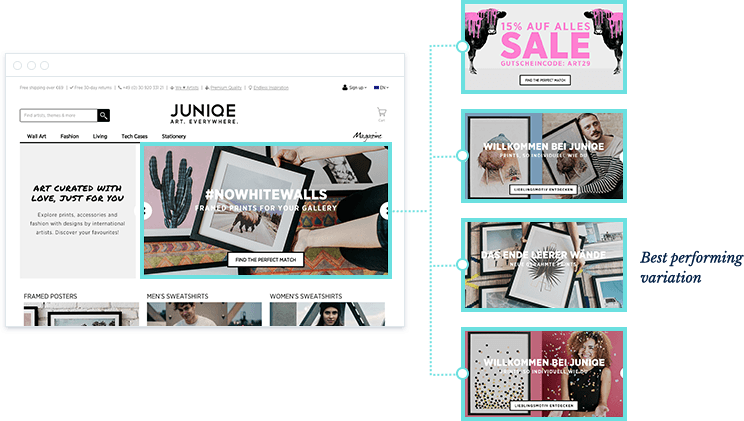Optimizing SEM traffic with personalization: A Juniqe.de case study
Learn how a leading online retailer used personalization to drive retention, promote discovery, and increase sales.
Summarize this articleHere’s what you need to know:
- Juniqe, a leading art retailer, uses personalization to drive sales and improve customer experience. They started by testing personalization features on a small group to promote product discovery and sales on the homepage.
- The company used predictive A/B testing to identify the best performing variations for homepage banners and product detail pages, ensuring the right products are shown to the right users.
- Juniqe also optimized their Google Ads Search campaigns by sending users to high-value landing pages based on their on-site behavior and traffic sources, further personalizing the ad experience.
- As a result of their personalization efforts, Juniqe increased revenue by 20% from their SEM campaigns and 8% from optimizing product detail pages, demonstrating the power of personalization for e-commerce.
Ensuring that website visitors have relevant experiences is critical to Juniqe, a leading art retailer disrupting the European mass art market. As a brand that features thousands of products from emerging and established artists, Juniqe was keen to learn how to serve the right combination of content, layouts, and experiences for each individual customer to increase sales and effectively deliver on the promises of omnichannel retailing.
“As with any eCommerce product, conversion rate was proving to be very crucial for us,” said Sebastian Hasebrink, Founder and Managing Director of Juniqe. “We had to get more rigorous about tracking everything that made that needle move. Being a lean engineering team, we were looking at solutions that could benefit us, preferably with a light involvement by the developers, and yet enable us to run experiments and build features in an agile fashion.”
Juniqe turned to personalization for its capability to use machine learning to automatically optimize and personalize customers’ digital experiences. With a personalization platform in hand, Juniqe could recommend products, continuously test and optimize pages, and automatically push content variations that generate the most revenue.
Start small with personalization, but end big
Juniqe started small, by testing different personalization features on a select audience group, with the goal of promoting product discovery and driving sales via the homepage. They began by testing homepage banner variations for desktop, mobile apps, and tablets.
The company had multiple active variations but had no way of identifying which yielded the best results. Using predictive A/B testing, Juniqe tested various banner variations and automatically pushed the top three variations that generated the most revenue per session (RPS). The company also created conditions to allow for banners with time-sensitive offers to replace these winning variations for set periods of time.

Used predictive A/B testing to automatically serve winning variations
“When we have an idea to personalize a part of the site experience, we will typically run a test so we can compare the impact of this personalized experience versus a control group,” said Hasebrink. On average, the test group produced a 15% to 20% revenue uplift compared to the control.
Additionally, Juniqe rearranged the content and layout of its product detail pages (PDPs), testing the assumption that having less content on the page would produce higher conversions. The company wanted to test that assumption. To find the optimal product page layout, the company tested various page elements with the conversion goal of increasing revenue. The optimal offering generated an 8% revenue uplift among those visiting the page.
Finally, Juniqe optimized its Google Ads Search campaigns, a critical customer acquisition channel for them. Rather than sending users to the homepage as it had in the past, the company A/B tested different page destinations and used link-level split URL testing to automatically redirect traffic to pages that generated the highest revenue post-click.

Used Dynamic Links to redirect traffic to high value landing pages
By implementing these dynamic links, the company was able to increase revenue by 20% from its SEM campaigns.
“Being able to test anything makes people move away from personal preferences and gut feelings to a ‘We don’t know, let’s test it’ attitude,” said Hasebrink. “That’s the beauty of using personalization because we can choose from a number of banners that all fit our style, are on-brand and very nice to look at. It gives us the opportunity to — on autopilot — optimize that based on on-site behavior and traffic sources. Without having to involve developers, we are a lot faster in making changes to our web site.”
Find more website personalization examples from real brands across the world in our Inspiration Library.

